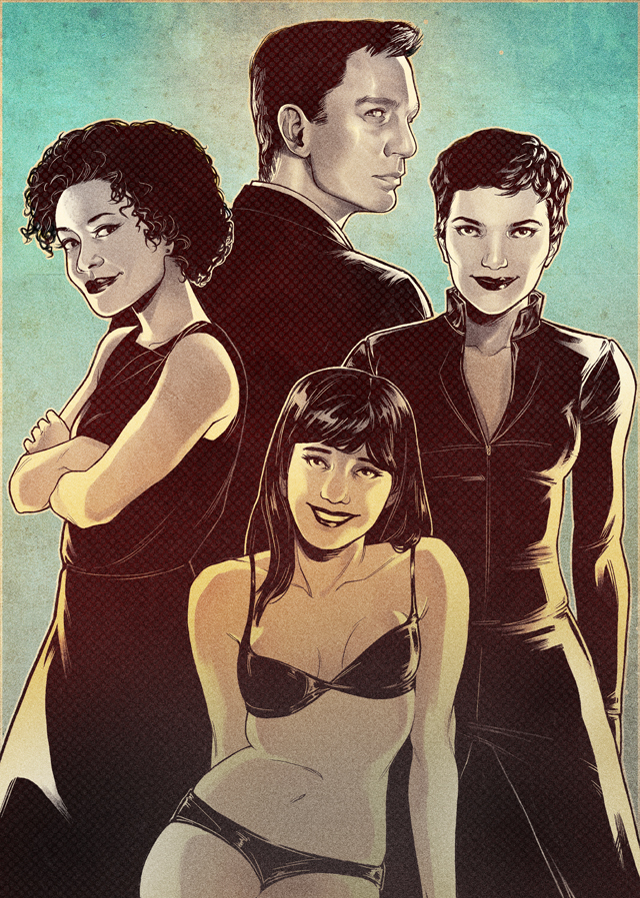
Original illustration by Emilie Majarian for The Mary Sue.
Welcome to Bond Girl, a new series where we’ll be re-watching and re-evaluating every James Bond film until Spectre’s release. Content warnings for: behavior read as sexual assault/coercion; heterosexism and lesbian erasure; brief mentions of domestic abuse and violence against women.
The thing about any long-running franchise is that certain images, ideas, and tropes become iconic. These parts become important to fans and are so recognizable that non-fans can identify the franchise or get a joke just from the reference. These iconic images not only define the character around which the direct reference revolves, but also the franchise itself. Fans and non-fans alike draw connections between iconic imagery or text and the source material within seconds of seeing the former. With the James Bond film franchise passing its fiftieth anniversary, there’s no doubt that the franchise has its fair share of iconic moments, images, lines and characters – and none are more so than those from Goldfinger.
The third film in the franchise and based on Ian Fleming’s seventh James Bond novel, Goldfinger is rife with iconic moments. Where From Russia With Love was the movie that the cast and crew said was one of their favorite or the “best” in the franchise (to which I found myself disagreeing strongly), there’s so much about the series’ permanent set up that was finalized in Goldfinger. On top of that, there’s a lot of the series itself that was so iconic that it became common knowledge, and in some ways, part of our cultural identity, even though we’re not all British/from a country that the British colonized.
There’s good and bad to that, and I had fun trying to pick out the ways that this film would influence the ones that came afterwards.
Goldfinger‘s plot to me is the most interesting of Connery’s Bond films so far. After James Bond is brought in to find out how gold smuggler Auric Goldfinger gets his gold out of the country. The main chunk of the plot revolves around Goldfinger and his fiendish plan to contaminate the gold in Fort Knox with a nuclear bomb gained from China so that the value of his gold goes up while the world is thrown into economic chaos.
One of my favorite things about the series is how it’s an interesting look at the history of the time and how certain things just weren’t done in film. Replacing SMERSH/SPECTRE as the main muscle in the plot with communist agents from China reads as if the secret societies’ widespread interference was less believable than British and Chinese elements working together to interfere with gold prices.
The plot is easy to follow and doesn’t, at first glance, look as if there’s anything about it that would immediately stand out as iconic.
But here’s the thing – I remembered this plot.
Dialogue came back to me immediately and I could quote a good twenty-five percent of the movie without needing subtitles. Characters were familiar in a way that they aren’t in the James Bond films that I’ve recently seen because they’re crafted in such a way that it pings your mind. They’re so good or so terrible that your brain latches on to them, and then whenever a reference is made to them, it grabs you, and you get that ridiculous “Oh my gosh! I know this character!” reaction.
For this re-evaluating post, I’m going to change the format up a little bit. While I do intend to talk about racism, sexism, and fridging women as it relates to the iconic nature of the film and its parts, this recap will be separated into sections focusing on the gadgets, the women in the film (and their treatment), and the villains. I’m also going to devote a bit of this post to the dialogue/iconic interplay between the characters because the film had some of the best dialogue ever!
Let’s start with gadgets and the genius behind them.
Last review, the first thing that came to mind when I was trying to figure out what I was most excited for in the next film was the Aston Martin DB5. It’s basically the only car I have ever able to recognize on sight besides Dean Winchester’s ’67 Impala. Out of the things that I remembered about Goldfinger without looking up the film and having immediate recognition, the Aston Martin and Q’s reveal of its features were number one.
This isn’t the first time that we’ve been through the gadget spiel (I mean, it’s so popular that Totally Spies did something similar in every episode as part of their formula!) In Goldfinger, what we get that’s new is the first seeds in the lightheartedly antagonistic relationship between Desmond Llewelyn’s Q and Connery’s James Bond. It’s such an integral portion of the series that here we are fifty years later with Ben Whishaw and Daniel Craig playing out the same mildly antagonistic role.
It’s familiar and it’s fun.
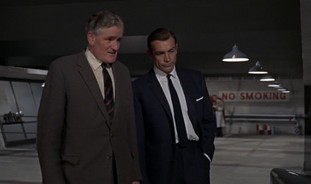
You have Bond wandering through the Q division touching things he really shouldn’t (including something that looks like a grenade in one scene) and casually putting down Q’s work. Then we get to see Q giving faintly hurt and definitely offended responses.
One of my favorite bits of dialogue in the whole movie comes during the Q/Bond banter. Q is midway through explaining the way that the Aston Martin DB5’s gadgetry works and then he gets to the ejector seat controls in the stick shift –
Bond: Ejector seat? You’re joking!
[Q makes the most disappointed face ever.]
Q: I never joke about my work, 007. [Bond falls silent]
The comedic timing is perfect. Both Q and Bond’s expressions are priceless.
It’s the sort of look and the kind of banter that sets the stage for what is essentially a lifelong relationship between these two characters.
Aside from the Aston Martin itself, other gadgets that I felt were iconic were the gold-melting laser used in several scenes, and the GPS devices stuffed into the shoes. These devices were things that either didn’t exist when Fleming was first writing the books or that didn’t exist to the capacity that they’re used for in the films. The application of evolving technology is just so cool to me. The Eon team could have gone with the plot points that Fleming wrote in the book and stuck to it 100%, but instead they decided to apply modern technology to the film.
Now despite how interesting I found Goldfinger to be, it wasn’t perfect. A simultaneous low and high point for me during the film was how the main lady characters were treated. Out of the main four women (Jill and Till Masterson, Miss Moneypenny, and Pussy Galore), only the latter two survive. On top of that, Pussy Galore, a character I truly loved and thought was cool, gets the short end of the stick when it comes to having her agency and identity respected.
Let’s start with the Masterson sisters.

One of the things that people bring up often when it comes to James Bond is the scene in Goldfinger where Bond is knocked out by Goldfinger’s silent muscle Oddjob and wakes up only to find Jill Masterson’s gold-painted body in the bed they’d been sharing only a few minutes ago. The scene is taken almost directly from Fleming’s original book and was so captivating that the actress that played Jill Masterson (Shirley Eaton) actually wound up on the November 1964 cover of Life Magazine.
The image of Jill Masterson’s gold-painted body became representative of what the Bond film franchise was about to the point where the scene wound up recreated in 2006’s Casino Royale with the gold paint replaced with crude oil.
Seriously, I have an issue with this. I hate how the images of women in nerd culture that people call “iconic” tend to be the ones where they’re hurting, dead, or in some way degraded for the male gaze. The facts leading up to Jill’s death don’t even make matters better.
Jill is fridged, but there’s no doubt that she’s also being punished within the narrative for having sex. Auric Goldfinger has her killed because he wants to strike fear into Bond’s heart and show him how easily reached he is, but there’s more to it than that. He has Jill Masterson killed because she had sex with James Bond and because he sees her behavior as a betrayal. But we’re supposed to think that her death scene is iconic and so cool that it gets brought up all the time. I can’t stand it. I also can’t stand how the other Masterson sister meets her end.
Tilly comes in during the part of the film set in Geneva. At first, I thought she was going to be the main Bond Girl because I remembered Pussy Galore as a villain and Jill had been dead for a good fifteen minutes at that point. Tilly was pretty. She was sharp. She was determined to kill Goldfinger herself for what he did to Jill.
So of course she dies.
I wasn’t expecting it. Normally, I can handle most character deaths as long as I’m not watching a Disney film, but Tilly’s death caught me by surprise. At this point, both Masterson sisters are dead, and their deaths are meant to motivate Bond.
It’s textbook fridging, and it’s annoying as heck to deal with because of how most of the Bond girls are never mentioned again. Once they’re dead or the movie’s done, that’s it, because Bond will have moved on to the next woman he finds. (Which is weird, because in the novels we do get references to Bond’s old flames and many of them are happy and successful in their relationships. Fleming’s original books may not be the best when it comes to women and their representation, but at least the women in Bond’s past aren’t erased.)
Now I know that Miss Moneypenny has been my eternal favorite in the franchise, and she still is, but for Goldfinger at least, Honor Blackman’s Pussy Galore stole her spot in my heart. She’s assertive, independent, and able to hold her own. She shoots down all of Bond’s attempts to charm her, and then she kicks his ass.
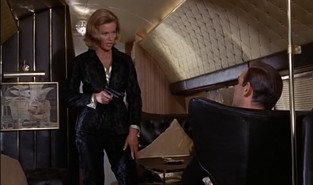
I mean, there’s a lot to love about her.
There’s also a fair bit to feel uncomfortable about.
In the books, Pussy Galore is a lesbian. In the film, despite Honor Blackman saying that she played Pussy Galore true to the books, she’s supposed to be simply “immune” to Bond’s charm and his attempts to flirt with her. Either way, we get this incredibly uncomfortable set of scenes while they’re at Goldfinger’s stud farm in Kentucky where Bond “seduces” her.
It’s seduction for a very loose value of the word, especially when you consider the dialogue leading up to it:
Bond: I’d like to think you’re not in on all of this, uh, caper.
Pussy: Skip it. I’m not interested. Let’s go.
Bond: [Bond grabs her arm and turns her back] What would it take for you to see things my way?
Pussy: A lot more than you’ve got.
Bond: [looking into her eyes] How do you know?
Pussy: I don’t want to know.
It’s played off as funny, that Pussy Galore isn’t interested in Bond. You know from the start that there’s no mutual attraction between them. Bond’s interested, but Pussy Galore isn’t having any of it.
After that back and forth, there’s a fight between Bond and Pussy Galore that ends with him on top of her and trying to kiss her. The body language in that scene is so clear: she’s turning her head and struggling. It’s plain as day that she doesn’t want to kiss him, but of course, James Bond always gets what he wants, and so he gets her. Since Bond is the hero, there are no long-term issues. After surrendering (to what we’re supposed to believe is Bond’s fantastic charm), Pussy Galore neatly switches sides and everything is perfect between them.
This was the scene that nearly made me want to give up on watching the movie altogether, because it was just too much. I’m only halfway through Connery’s movies and I’m getting so tired of watching him manhandle women. Aside from Moneypenny getting the work-wife treatment, so far Bond’s relationships are so cringeworthy that I don’t understand why the same patterns repeat in later films.
With Honey in Dr. No, he was weirdly paternalistic.
He hit Tatiana in From Russia With Love and frightened her.
And here with Pussy Galore, he surges into a “seduction” that feels far from consensual. It feels like he took her disinterest (and possibly her sexuality) as a challenge that he had to overcome. Healthy relationships aren’t James Bond’s thing, and I really want to know why the hell no one’s really changed that in fifty years. He’s supposed to be a playboy. I can get that. But that doesn’t explain his behavior or why it’s set a tone so long-lasting.
This is my favorite film so far in this rewatch, but I still want to shake Bond so hard, mainly because of his interactions with Pussy Galore.
Thankfully, his interactions with the other villainous characters in the film aren’t half as difficult to watch.
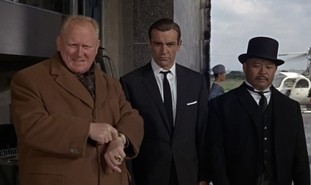
Aside from how disposably he appeared to view women, my biggest issue with Goldfinger was that Goldfinger didn’t do enough to get involved. He wasn’t hands-on the way that Dr. No and Red Grant were in the previous films. He delegated and had his minions do the work. Maybe it’s just that I’ve been spoiled by all the hand-to-hand, but I wanted a little bit more from him.
The best thing about Goldfinger was his dialogue.
He’s quick and gets back at Bond mostly with witty commentary.
My favorite scene with Goldfinger is, of course, that iconic scene where Bond is on his back with the laser beam heading steadily towards him. At the end of his rope, Bond fishes for something that he can say that can keep him alive for a few seconds as Goldfinger walks away from him. What we get is my favorite piece of dialogue in the franchise’s history, maybe even all of film history –
Bond: Do you expect me to talk?
Goldfinger: [looks back, laughing] No, Mr Bond, I expect you to die!
It was glorious. I was expecting it, of course, but that didn’t stop me from feeling this ridiculous glee at hearing Goldfinger deliver that line. I might not remember all of the villains in the Bond franchise or what they said to the man when he was at their mercy, but I did remember that line. Goldfinger might not have been the most frightening villain or the most involved, but he had great dialogue!
Now, with all of my focus on how much I loved the dialogue in Goldinger, it’s probably going to come as a huge surprise that my favorite character is one that doesn’t actually get to speak. Harold Sakata plays Oddjob perfectly. He’s a menacing figure in the way that Goldfinger isn’t, and his lack of dialogue only highlights that. He’s got an advantage over Bond in both size and strength, and he uses it to subdue Bond easily.
One of the things I mentioned in my last review was that I was looking forward to the fight scene in this film that was supposedly one of the best in the entire franchise. After watching James Bond struggle with Red Grant, I wasn’t sure that anything could top the edge of the seat anxiety that fight scene caused me.
I was so wrong.
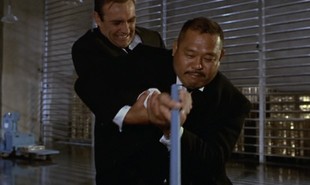
Sakata’s Oddjob is the best. He’s a heavy hitting fighter and easily wipes the floor with Bond. I mean, the blows that he was delivering looked painful and he was flinging James Bond around like it was no big deal! There was no way for James Bond to win that fight fairly and he didn’t. Because Bond couldn’t take Oddjob down in hand-to-hand combat, he tricked the man and electrocuted him because that was probably the only the way that he’d win. It was such a good fight scene, and Oddjob was such an amazing villain that I found myself wishing that he’d survive long enough that I could hope that he’d get to appear in another Bond film.
Overall, despite my major gripes with fridging and Pussy Galore, Goldfinger was good. It shines in terms of the fight scenes and the dynamics that the characters have with one another. My biggest issue is how easily brief moments in the film made my opinions on it change toward the negative. One minute I was set to mark Goldfinger down as my favorite Bond film yet, and in the next, I was full of anger about how we didn’t really have consistent and positive female characters that were iconic for reasons besides how they died or how beautiful they are.
I’m excited for Thunderball, though! Anything set in or around Miami during the ’60s is all but guaranteed to entertain me even if it’s for the worst reasons.
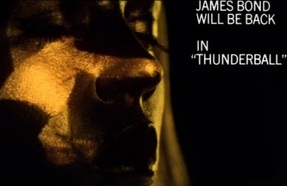
Things I’m looking forward to:
- Terrance Young directing his final Bond film! Guy Hamilton had an interesting style but I’m looking forward to Terrance Young’s Thunderball being the last Eon Productions Bond film I watch before the 1967 Casino Royale.
- All of the sharks! This movie is famous for its underwater scenes and since it’s primarily set in the Bahamas and Miami, I’m expecting sharks everywhere.
- I hate to admit it, but I’m looking forward to the first non-Eon Production James Bond film on my list and to taking a break from Sean Connery for a little bit after I watch Thunderball. I adored him when I was watching Dr. No but I think that I need reset my feelings on the character. Dealing with Connery’s Bond is hard because he’s got so many flaws that are put forward as positive or acceptable.
Stitch writes about comics, nerd history, and ridiculous romance novels when not working frantically on her first collection of short stories. Find her on her blog or on Twitter.
—Please make note of The Mary Sue’s general comment policy.—
Do you follow The Mary Sue on Twitter, Facebook, Tumblr, Pinterest, & Google +?



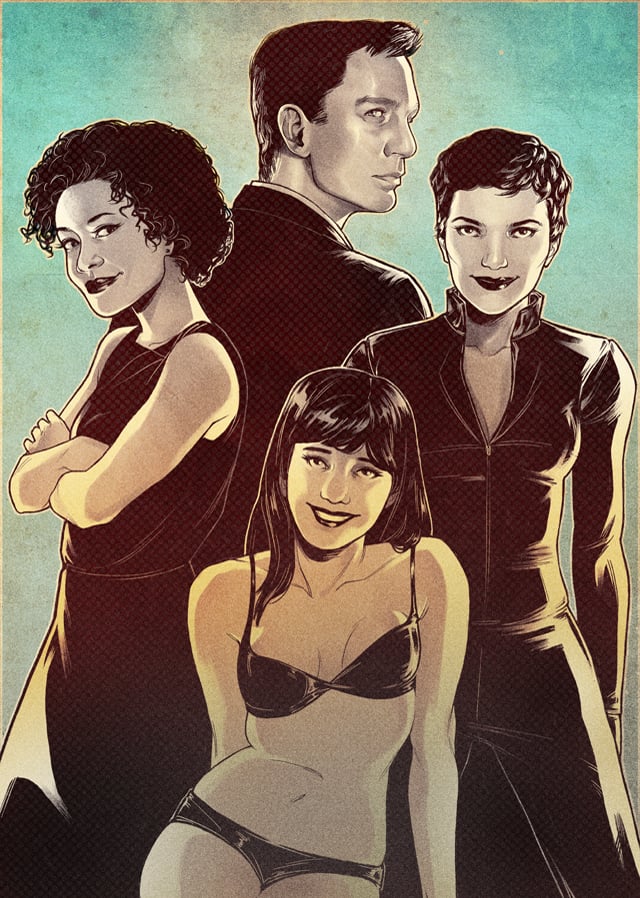





Published: Apr 20, 2015 08:00 pm